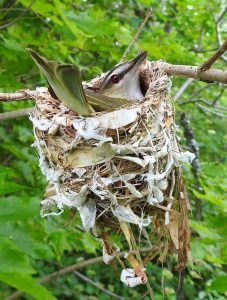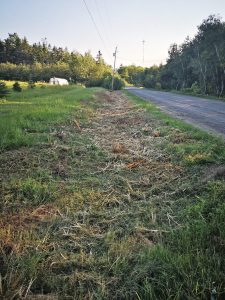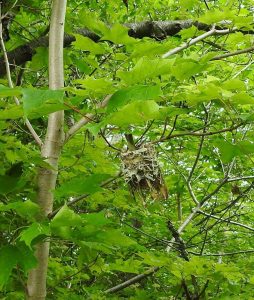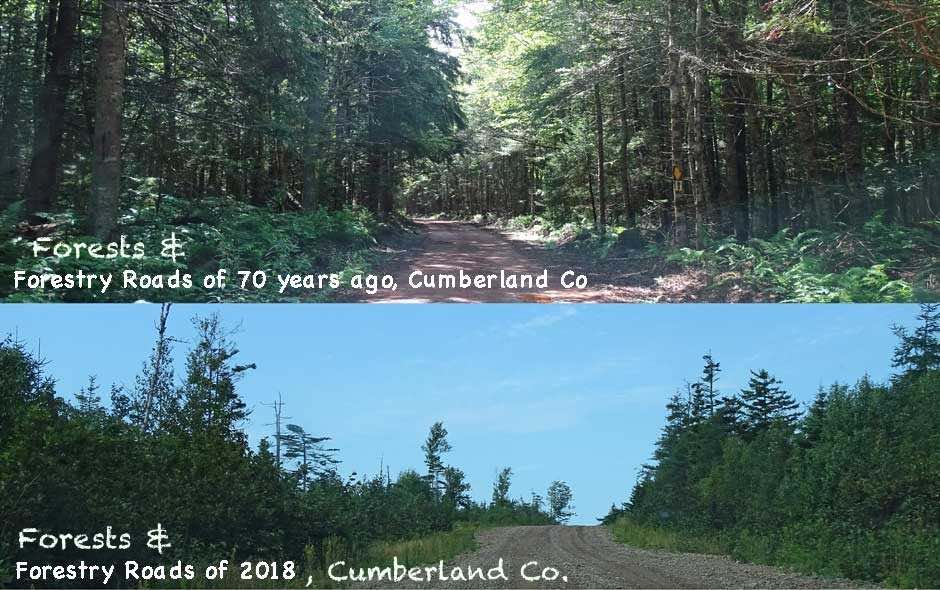
Photo #1 in Bev Wigney’s Letter to the Premier: A female Red-Eyed Vireo “sitting tight” on her nest of eggs which is fastened to a small Sugar Maple sapling inside the fencerow alongside Route 201 at the bridge at Round Hill on July 4, 2019.
Click on images for larger versions
It seems that new controversies about forestry in NS come up at fairly regular intervals, the “Lahey Report” (Aug 2018) and all of L&F’s stated intentions to follow Lahey’s recommendations notwithstanding.
The latest is an uproar about the use of “tree grinders” to clear wide swaths beside country roads.
It started with an op-ed penned by Marilyn Cameron of Hawthorn Hill Farm in Grafton N.S. and published in the Chronicle Herald on June 24, 2020 under the title MARILYN CAMERON: Tree grinders a blight on our beautiful roadways. From the Op-ed:
I was told we were “lucky” to be chosen for a capital upgrade to our beautiful, rural dirt road in Kings County. Directives for the project came from the “highest level of government.”
Our road in Grafton is relatively straight and lined with lovely young birch and maple trees and various wild bushes and grasses which provide habitat to an amazing array of birds and small mammals. We have woodpeckers, crackles, finches, swallows, sparrows, chickadees, robins, starlings, morning doves, red-winged blackbirds, cardinals, pheasants, flickers, ducks, red squirrels and chipmunks along our road. Many of them are now nesting. Roadside vegetation filters the air, softens noises, blocks wind and keeps dust from blowing into our yards and homes from the road.
The only problem that we have with our road is the potholes. A few weeks ago, we noticed some highway workers putting stakes in our lawn and asked what was being done. We were only told that the road will be resurfaced. No other consultation with the residents of the road was undertaken to inform us what road surfacing entailed.
Photo #2 in Bev Wigney’s Letter to the Premier: The same Red-Eyed Vireo nest as seen from a few steps away — showing how DIFFICULT it is to see a nest unless you already know it is there.
Then I discovered that one of those new tree grinders had arrived and was busy ripping and tearing out all the vegetation along one side of our road. It tore into all the vegetation at the edge of the road, down into the ditches and ground its way up at least 10 feet on the other side of the ditch. Trees and debris flew all over the road along with dirt.
…Perhaps it is just me who thinks that roadside vegetation removal in Nova Scotia has gone overboard? When one asks around, it seems everyone is just as disgusted as I am with the new, industrial appearance of the 100-series highways and on many of our rural roads.
This destructive, new practice in Nova Scotia needs to be severely curtailed. Employees need further training to learn how this type of machinery impacts the environment and our tourism potential. Managers should be informing residents about upcoming road projects and what exactly that work will entail. Tree grinders destroy much more than roadside vegetation and should be banned.
Read the complete op-ed in the Chronicle Herald
Naturalist/birdwatcher Bev Wigney who founded and manages the Facebook Group Annapolis Royal & Area – Environment & Ecology and whose activities raised the alarms about harvesting of the Corbett-Dalhousie Lakes Old Forest in the fall of 2018 and subsequently has campaigned to stop forest harvesting during nesting season (view petition launched in early June) made a post about Marilyn Cameron’s Op-ed on the Annapolis page, with the introduction
I’ve been noticing this too. It seems that nothing is ever done at the right time of year. No, have to do *everything* right at the peak of bird nesting season. Nothing done in moderation. Everything done from the seat of some big machine. Never any consultation with the public about what we would like to see happening. Why is that — all of the above?
Within two days, that post generated 45 comments and 13 shares, not surprisingly no one defended the practices.

Photo #3 in Bev Wigney’s Letter to the Premier: A recently PULVERIZED hedgerow along a rural road in Kings County that was full of nesting birds (photo by Tracy Horsman)
Early today Bev Wigney wrote the following open letter to Premier McNeil and urged others to follow up with more letters to the Premier (“Please do WRITE THOSE EMAILS about the BIRD DESTRUCTION – and send them!! It isn’t enough to share these posts and get angry and mutter to ourselves…Email addresses are at the bottom of this post. I always send to the constituency office as well as the Premier’s office.”)
Dear Premier McNeil,
I want to keep this short and direct and ask that you take action on this as soon as possible as every day counts.
Members of the Nova Scotia Bird Protectors group and our Annapolis Royal & Area Environment & Ecology group, have been watching with horror as “tree grinders” have been destroying the fencerow trees alongside roads for the past few weeks. I know that most politicians probably don’t have time to walk along a roadside in June, but the fencerows are absolutely FULL of nesting birds and their fledglings that have not yet learned to fly. I know this as I have a hedgerow right in front of my own house which is where I took the photos of a nesting bird that I have attached, along with a photo that was posted to our group, of a hedgerow in Kings County that was just pulverized into nothing — birds included. I’m sorry, but this kind of wanton destruction of wildlife just can’t go on. This is vicious and unacceptable anthropogenic behaviour in a province where we pride ourselves to be intelligent, compassionate human beings.
We have over a hundred species of birds that fly thousands of kilometers each spring to nest in the woods and hedgerows of this province from about mid May to the end of July. They come here, spend as much as 10 days building their nests, 2 or 3 weeks incubating their eggs, and then often a month feeding and raising young until they are fledged and can fly. During this time, they are vulnerable and easily destroyed by human activity — such as chopping down forests and grinding up hedgerows along roadsides. Those who do this kind of destruction claim that the birds will just flush and fly away. That is false, as demonstrated by my photo of the Red-eyed Vireo on her nest (photo attached) who is “sitting tight” with her eggs. Many birds will NOT flush off their nests and are chopped or pulverized by machines. The killing of these birds is also *illegal* under the terms of the Migratory Birds Convention Act. People in government are saying that it only protects “Species At Risk”. This is entirely false! The MBCA protects ALL migratory nesting birds. It is just as much a crime to grind up a Red-eyed Vireo nest such as the one in my photos, as it is to grind up a Canada Warbler nest!!
Can we not, as supposedly caring and humane inhabitants of Nova Scotia, find a way to STOP doing these activities during the most critical time for birds? There are 12 months in a year. In 2 of those months, there are birds nesting in our forests and hedgerows. Why is it that almost ALL destructive activities in this province occur during those SAME two months? There are TEN other months during which this kind of work could be done. Can we not do better? Do we have to behave like thugs who contribute to the rapidly increasing DECLINE of almost all bird species on this continent? Please discuss this with your colleagues and try to come up with an immediate solution to this unnecessary destruction. There are still a few weeks left of nesting season. Please make this happen a.s.a.p.
Thank you,
Bev Wigney
Round Hill, NSEmail addresses for Premier McNeil:
Stephen McNeil <stephenmcneil@ns.aliantzinc.ca>, “Premier Stephen McNeil: premier@novascotia.ca,” <premier@gov.ns.ca>
Bev writes from Premier McNeil’s riding and is hardly alone in her efforts to protect birds and the few Old Forest stands remaining in Annapolis Co. A group of Annapolis women camped out at the Dalhousie-Corbett Lakes site in early June of 2019 to stop logging activities there. Recently, they launched a fundraising campaign to buy 50 acres of Old Forest to keep it from being clearcut.

Sound of Silence [of harvesters] at Corbett-Dalhousie Lakes forest. June 15, 2019
My (late) Mom’s folks were Annapolis settlers and the women I knew or heard about going back to the late 1800s were definitely not ones to be dismissed lightly… nor are those of the same ilk today!
Regardless of any political pressure the Premier may or may not feel, I hope he will ‘do the right thing for the birds’ (and because it is 2020) and direct his ever reticent Dept of Lands and Forestry to do the same: take the actions necessary to stop logging and other activities such as roadside clearing and clearing for power lines during the nesting season.
Surely that could be done in short order for those operations under the government’s immediate jurisdiction.


